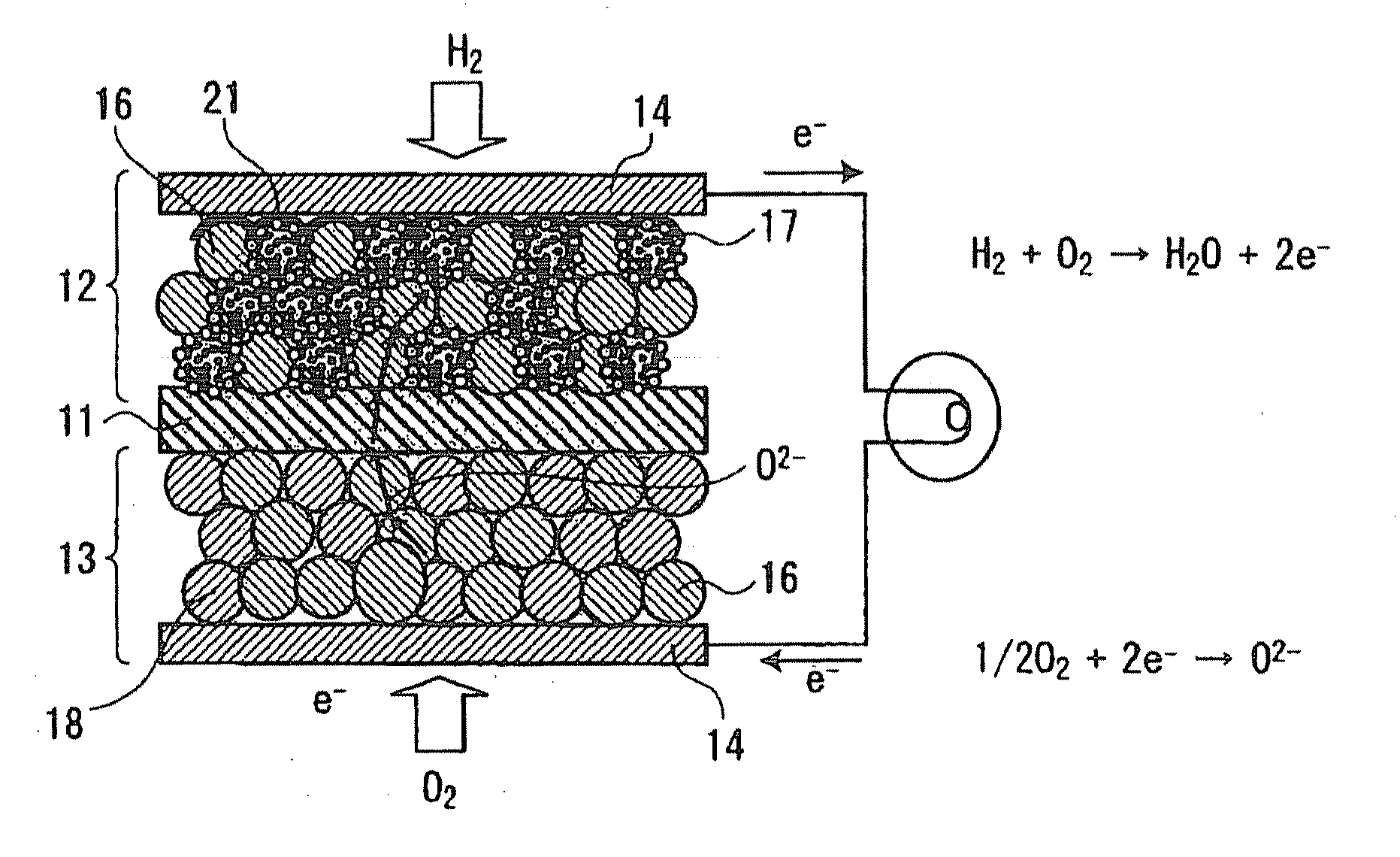Fuel electrodes for solid oxide electrochemical cell, processes for producing the same, and solid oxide electrochemical cells
a technology of electrochemical cells and fuel electrodes, which is applied in the manufacture of cell components, final product manufacture, electrochemical generators, etc., can solve the problems of unnecessarily large amount of nickel particles, risk of cell breakage, etc., and achieve high catalytic activity, excellent output performance, and high durability
- Summary
- Abstract
- Description
- Claims
- Application Information
AI Technical Summary
Benefits of technology
Problems solved by technology
Method used
Image
Examples
first embodiment
[0027]A first embodiment of the invention relates to the fuel electrode according to the first aspect of the invention, the process for producing this fuel electrode, and the solid oxide fuel cell employing this fuel electrode.
[0028]First, the solid oxide fuel cell according to this embodiment is explained by reference to the diagrammatic sectional view of FIG. 1. This solid oxide fuel cell has a multilayer structure composed of a solid electrolyte plate 11 having oxygen ion conductivity, a fuel electrode 12 disposed on one side of the plate 11, and an air electrode 13 disposed on the other side thereof.
[0029]The air electrode 13 includes composite oxide particles 18 which are particles of an oxide showing mixed electrical conductivity and represented by the general formula Ln1-xAxBO3-δ (wherein Ln is a rare-earth element; A is Sr, Ca, or Ba; and B is at least one of Cr, Mn, Fe, Co, and Ni). These composite oxide particles 18 efficiently dissociate oxygen and have electronic conduct...
examples 1 to 3
[0063]An NiO powder having an average particle diameter of about 1 μm and an Al2O3 powder having an average particle diameter of about 0.4 μm were weighed out in such amounts as to result in a molar ratio of 1:1. The powders were mixed together by means of a mortar. The resultant powder mixture was press-molded, and the molding was sintered at 1,300° C. of 5 hours in the air. The constituent phases of the sinter obtained were examined by X-ray diffractometry.
[0064]Subsequently, the sinter was pulverized and passed through a 40-μm mesh sieve to obtain a starting powder (nickel-aluminum composite oxide). The pulverized composite oxide particles were mixed with YSZ (ZrO2 stabilized with 8 mol % Y2O3) particles having an average particle diameter of 0.6 μm in each of such ratios as to result in pulverized-particle proportions of 10, 20, and 50% by weight. Thus, respective powder mixtures were prepared (Examples 1 to 3).
[0065]To each of the powder mixtures was added about 40% by weight p...
example 4
[0067]A CoO powder having an average particle diameter of about 1 μm and an Al2O3 powder having an average particle diameter of about 0.4 μm were weighed out in such amounts as to result in a molar ratio of 1:1. The powders were mixed together by means of a mortar. The resultant powder mixture was press-molded, and the molding was sintered at 1,300° C. of 5 hours in the air. The constituent phases of the sinter obtained were examined by X-ray diffractometry.
[0068]Subsequently, the sinter was pulverized and passed through a 40-μm mesh sieve to obtain a starting powder (cobalt-aluminum composite oxide). The pulverized composite oxide particles were mixed with YSZ (ZrO2 stabilized with 8 mol % Y2O3) particles having an average particle diameter of 0.6 μm in such a ratio as to result in a pulverized-particle proportion of 20% by weight. Thus, a powder mixture was prepared. To the powder mixture was added about 40% by weight pure water. The resultant mixture was treated with a high-speed...
PUM
 Login to View More
Login to View More Abstract
Description
Claims
Application Information
 Login to View More
Login to View More - R&D
- Intellectual Property
- Life Sciences
- Materials
- Tech Scout
- Unparalleled Data Quality
- Higher Quality Content
- 60% Fewer Hallucinations
Browse by: Latest US Patents, China's latest patents, Technical Efficacy Thesaurus, Application Domain, Technology Topic, Popular Technical Reports.
© 2025 PatSnap. All rights reserved.Legal|Privacy policy|Modern Slavery Act Transparency Statement|Sitemap|About US| Contact US: help@patsnap.com



